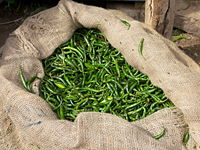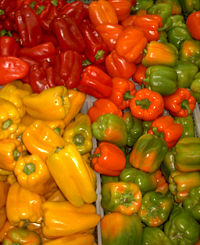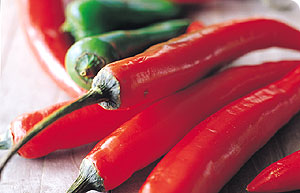Chillies



Indian Green chillies Assorted Peppers Pepper Chillies
Part of the capsicum family, chillies come sizes, long thin to short and plump and colour, from green through to yellow, orange and red, and are one of the most popular spices in the world. Chillies can be used fresh, dried or powdered, and the level of heat varies from type to type, from sweet and mellow to blisteringly hot - as a general rule, the smaller the chilli, the hotter the taste. The substance that generates the heat is called capsaicin, which is found mainly in the pith and, to a lesser extent, the seeds. But it's not all about heat - each type has its own distinct flavour. Neither cooking nor freezing reduces the intensity of capsaicin but removing the seeds and veins is the only way to reduce a chilli's heat.
Certain chilli varieties are known to be hotter than others, but it's worth bearing in mind that even on the same plant individual fruits can contain different levels of capsaicin. To prepare fresh chillies, slit them lengthwise, remove the seeds and membranes with the tip of the knife and cut off the stem. Rinse them under cold running water and then prepare according to the recipe. After working with chillies, it's extremely important to wash your hands thoroughly. Failure to do so can result in painful burning of the eyes or skin - wearing rubber gloves is a good tip.
Dried chillies are a great ingredient to have on hand in the kitchen, as they'll keep for around 12 months if stored in an airtight container away from direct sunlight. Although mainly known for their heat, chillies can add flavour to bland dishes, and a small amount of finely chopped chilli is good with grains, pulses or mildly flavoured root vegetables.
Yarlpanam and Indian cooking has multiple uses for chillies, from snacks like baji where the chillies are dipped in batter and fried to the notoriously hot snack. Chillies are also dried and roasted and salted for later use in conjunction with other spices in curries and fried meat and fish etc. ‘Sambal' is dipping sauce made from chilli with many other ingredients such as garlic, onion, shallots, salt, vinegar and sugar, which is very popular in Indonesia, Malaysia and Singapore. ‘Sambol' in Yarlpanam has a slightly different meaning in that it is hot spicy paste made from chillies, coconut scrapings, salt onion and tamarind to accompany most breakfast dishes. In South India a milder version of this is made with a name Chutney.
Green chillies are soaked and marinated in butter milk and salt in an earthen pot for five to six days, stirred daily. After this period, the pot is placed covered in the sun for a further period of 4 days. Thereafter chillies are removed from the buttermilk and sun dried in the day time and re soaked in the buttermilk in the night. This process of soaking and drying daily is repeated until all the buttermilk has been exhausted. When completely dry it is butter chillies or curd chillies and these can be stored in dry containers for a long period of time. These are deep fried and eaten as an accompaniment with rice. This is a fairly common practice in Yarlpanam.






